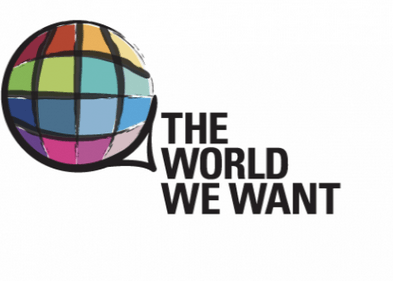The Social Good Summit kicked off today in New York with the overriding theme of envisioning the world we want in 2030. This theme is timely as the UN and international community works together to form the post-2015 development agenda. Not surprisingly, the power of youth in achieving social change is a recurring theme for many of the participants. From government officials and corporate leaders to civil society activists and UN officials, speakers agreed that youth around the world will be the real change agents of our time and must be engaged to better take advantage of their potential.
The opening discussion on the intersection of digital media and youth in shaping our world set the tone for many discussions that followed. Helen Clark, Administrator of the UNDP, highlighted how far we have come in the last 15 years thanks to technology and how much potential it has for continuing to transform the world we live in, not just through connectivity but through the outcomes of that connectivity. No longer are people focused solely on a single outcome – profit and shareholders within the private sector, international relations for governments, and narrow causes among civil society organizations. Instead people, led by the youth generation, are demanding more interaction, more engagement and more accountability among all the relevant partners to develop real solutions on the ground to meet problems around the world.
But how does such change start? Zeenat Rahman who serves as a Special Advisor for Global Youth Issues at the US Department of State acknowledged that governments, NGOs and business are increasingly realizing that such change must start first with listening and then with a two-way conversation with those on the ground and the next generation of leaders. This is because as the UN Secretary-General’s Envoy on Youth Ahmed Alhendawi puts it, the post-2015 agenda is not just a policy tool but a social contract for the entire international community. The current generation of youth, the largest ever in the world, will be tasked with carrying it out but also serve to benefit the most from it. More bluntly put by Jeff Martin of Tribal Technologies, “Young people need to be asked what needs to change, not be told what needs to be changed.” Pursuing a path of youth engagement and public outreach initiatives such as the MY World campaign as the post-2015 agenda is developed is needed to properly understand what the world’s greatest needs are now and to form an effective policy that will involve real solutions for big problems.
Even though multiple speakers echoed these sentiments throughout the day, achieving this change will be difficult as it represents a substantial shift in the individual cultures of governments, businesses and philanthropy. While technology is opening up many avenues for this change, there is inevitably some resistance from traditional standard bearers who are used to a more closed institutional culture. But thanks to technology, especially tools like social media, change is coming to these institutions as the next generation comes of age to take up their role as future leaders. This is where the real promise of youth can be seen; as Kathy Calvin of the UN Foundation said, the true power of youth and technology is not just the power of individuals, but the power of individuals coming together. With more engagement and dialogue between stakeholders around the world especially the young, the better our chances are of bringing about a real global culture of social good and creating the world we want in 2030.
